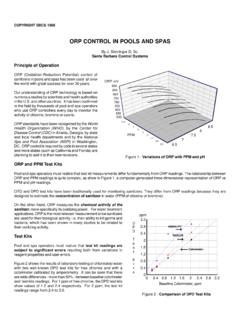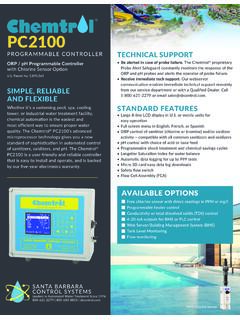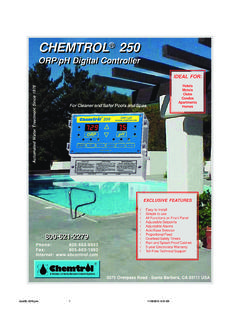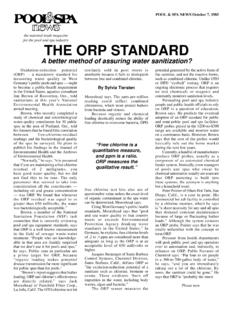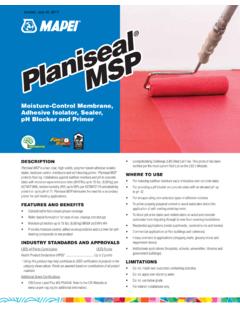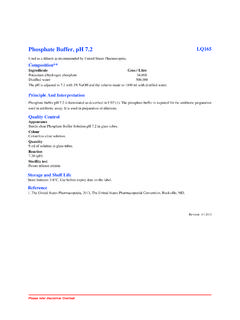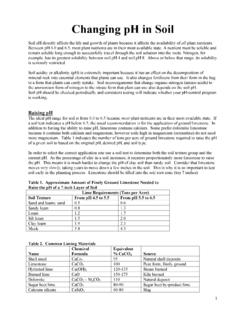Transcription of PPM or ORP: Which Should Be Used? - CHEMTROL …
1 Swimming Pool Age & Spa Merchandiser, November 1985 ppm or orp : Which Should Be Used? Water treatment experts arebecoming increasingly aware thatwater disinfection is dependent upon ORPand not the free residual chlorine JACQUES M. STEININGEROver the past few years, therehas been an increasing recognition amongwater treatment specialists and healthofficials that the oxidation-reductionpotential (ORP or Redox) can provide aneffective measure of sanitizer activity inpool or spa technology has beenrecognized and incorporated into Europeanand world water standards for several 1972, the World Health Organizationrecognized in its Standards for DrinkingWater (WHO 1972) that at an ORP levelof 650 millivolts (mV), water isdisinfected and viral inactivation is 1968, a laboratory study byCarlson, Hasselbarth and Mecke ofthe Water Hygiene Institute of theGerman Federal Health Officeshowed that the rate of killing of organisms in swimming pool water isdependent on ORP and not on the freeresidual chlorine level.
2 As shown in Figure1, the kill time is just a fraction of a secondat a Redox level of 650 mV, but it increasesrapidly to several hours at lower Germany and other Europeancountries where public health standards arevery high, a minimum ORP level of 750mV is required by DIN Standard 19643(adopted in 1982) for public pools and DINS tandard 19644 for spas (December1984).In the , many public pools andspas use ORP controllers for automaticchlorine control but this is disguised bythe fact that the controller readouts usuallyare labeled in parts per million (ppm) offree chlorine instead of the moremeaningful ORP mV. More recently,however, manufacturers of ozonegenerators and industry consultants havecalled for the use of ORP to monitor theeffectiveness of disinfection in ozone/chlorine StudyThis June, James C. Brown, aconsultant formerly with the OregonState Health Department, presentedto the National EnvironmentalHealth Association Conference inLas Vegas the results of a remarkable fieldstudy on Chemical andMicrobiology Water Quality Constituentsof 30 Public Spas in metropolitanPortland, (et al.)
3 Found that: Totaland fecal coliform parameters provedto be unreliable indicators ofbacteriological water quality (but) theoxidation reduction potential (ORP) wasfound to be a reliable indicator ofbacteriological water quality. Watershaving an ORP equal to or higherthan 650 mV were well within acceptedbacterial parameters. The key data from this study hasbeen computer-sorted and listed bydecreasing ORP values in Table ORP values range from a high of867 mV to a low of 296 mV, with anaverage of 643 mV. As noted byBrown, both the plate count and thepseudomonas count showed a highdegree of correlation with the ORPlevel the high counts being foundsystematically in the bottom half ofthe list, below the 650 mV free chlorine level in the 30spas included in the study variedfrom a low of ppm to a high of30 ppm, with an average of ppmin spas without cyanurates and in spas using cyanurates.
4 ThepH varied from a low of to a highof cyanuric acid level varied fromzero in the five spas using sodium orcalcium hypochlorite to a high of1,300 ppm in spas using cyanurates,with an average of 228 ppm in thecyanurated spas. This, of course, iswell in excess of the maximumrecommended values - 100 ppm, forinstance, in CaliforniaFigure 1 Kill time of E. Coli as a function of Diego SurveyThese results unfortunately confirmthose of a recent survey of commercialspas in San Diego, Calif., where more than50 percent of the spas were found out ofcompliance with health view of the wide variations inthe levels of free chlorine, pH andcyanuric acid in the Oregon study, itis remarkable that the key indicatorof bacteriological water quality was notppm of free chlorine, as generallyexpected, but the ORP level,clearly confirming the earlier study ofswimming pool waters in.
5 Addition, both studies found thesame minimum ORP level of 650 mVfor safe water quality, whether cyanuricacid is used or results are expected to havea profound impact on water treatmentprocedures in this country, particularly incommercial spas but also in all publicpools and spas. There is a need, therefore,for a new and comprehensive analysis ofsanitizer chemistry in order to provide abetter understanding of the reasons whyORP readings have been so successful inmonitoring sanitizer and Combined ChlorineWhen chlorine in any form isintroduced into pool or spa water, itforms free chlorine (HOCl), Which isan excellent bactericide:Cl2 + H2O ---> HOCl + HCl (1)Chlorine Water Free Hydrochloric Chlorine AcidFree chlorine, however, readilycombines with organic waste materials thatare present in the water (such as bodyperspiration, urine, cosmetics, hair spraysor other ammoniated compounds) to formcombined chlorine compounds calledchloramines, Which are poor bactericidesand have obnoxious now, everybody in the pool andspa industry is or Should be familiarwith chloramines.
6 However, themechanisms of formation and destructionof chloramines generally are poorlyunderstood in the chemistry of chlorine in wateris controlled by a very important factor:the ratio of free chlorine dividedby the concentration of nitrogen orammonia radicals in the water. For properwater sanitation, this ratioshould be as high as possible. Whenever itis allowed to fall below 5:1 by weight(either through chlorine loss or byintroduction of waste products),essentially all the chlorine inthe water is converted into compoundscalled monochloramines, such as NHCl2:NH2 CONH2 + 2 HOCl --->Ammoniated FreeCompounds Chlorine 2NH2Cl + CO2 + H2O (2) MonochloramineAt a pH of seven to eight, thisreaction takes place in a fraction of asecond. Although chloramines havesome bactericidal properties, their killratios for various micro-organismsare as much as 80 to 100 times lowerthan those of free chlorine, the ratio of chlorine tonitrogen is progressively increased backabove 5:1 by the addition of smallamounts of chlorine, themonochloramines are transformed intoother types of compounds calleddichloramines, such as NHCl2:NH2 CONH2 + 4 HOCl --->Ammoniated FreeCompounds Chlorine 2 NHCL2 + CO2 + 3 H20 (3) DichloramineDichloramines are even worse thanmonochloramines.
7 They are notorious fortheir bad smell (the so-called chlorineodor ) and for eye irritation. They are thesource of most customer complaints aboutpublic pools and , when more chlorine isadded to the water and the ratio ofchlorine to nitrogen is increased to10:1, the mono- and dichloraminesare almost completely destroyed andare converted back into inoffensivecompounds, such as nitrogen compoundsand chloride salts. This can be representedwith some simplification by reactions ofthe type:NH2 CONH2 + 6 HOCl --->Ammoniated FreeCompounds Chlorine N2+ 6 C l+ CO2 + 5 H20 (4)This last equation corresponds towhat is generally known as breakpointchlorination. To prevent chloramineformation, a constant state of breakpointchlorination is required. In other words,the free chlorine level must be at least 10times the level of ammoniated compoundsin the water at all times.
8 This can beaccomplished only with frequent testingof the water or, more easily and reliably,with automated Forms of Free ChlorineUp to this point, we have assumedthat the pH of the water remains low,( below ). Now, the picture isfurther complicated by the fact thatthere are two forms of free chlorine: the molecular form, hypochlorousacid, HOCl, Which is the fast-actingfree chlorine, and the ionic form, OCl-, Which is aslow-acting is a weak acid. As the pHincreases, it dissociates to producethe hypochlorite ion and a hydrogenion:HOCl <---> OCl- + H+ (5)Hypochlorous Hypochlorite HydrogenAcid Ion IonThe equilibrium constant at 20 Cis x 10-8. Figure 2 shows the familiarionization curve for HOCl, representingthe above reaction. Note that theconcentration of HOCl, the fast-actingsanitizer, decreases very rapidly withincreasing pH in the range of interest forpools and spas (7 to 8): At a pH of , about 75 percentof the free chlorine is is remarkable that the key indicator ofbacteriological water quality was not ppm of freechlorine, as generally expected, but the ORP level,clearty confirming the earlier study in Germany.
9 At a pH of , it is about 50/50 HCOl and OCl-. At a pH of , it is about 20 percentHCOl and 80 percent is 80 to 300 times moreeffective than OCl-. For instance, it ismore than 100 times more effectivethan OCl- against cysts and 60 to 70times more effective against E. activity of OCl- as a sanitizertherefore can be compared to that ofchloramines, ( much below that ofHCOl).For good bacteriological quality, itis therefore essential to maintain aproper HCOl level in the water at alltimes. Total free chlorine readings, Which combine both HCOl andOCl , cannot be depended upon forproper water , the DPD test kitand other free chlorine test kits donot differentiate between the twoforms of free chlorine. Therefore,they cannot show the decrease inHCOl concentration when the pH isincreased. This is no problem if thepH remains where it Should be - to However, if the pH is allowedto rise - through the additionof an alkaline sanitizer, of alkalinemake-up water or just body perspiration -the concentration of HCOl can decreaseto almost zero even though the DPD testkit still shows the same level of increase in pH can take placevery easily, especially if the water ischlorinated with one of the alkalineforms of chlorine sodium hypochlorite(liquid bleach), NaOCl or, to amuch lesser extent, calcium hypochlorite,Ca(OCl)2 or if the total alkalinity levelsare too low to adequately buffer the wateragainst pH , above a pH of 8, almostall the free chlorine is useless -and the DPD test kit does not showitFree Chlorine and ORPF ortunately, there is another wayof testing the water that is both simple andreliable.
10 It is called or Redox refers to the oxidation-reduction potential - a measure of theoxidizing properties of the sanitizer inwater - Which is determined by a sensorwith a noble metal electrode, usuallyplatinum, and a standard Ag/AgClreference an ORP sensor is placed inwater containing a sanitizer - suchas chlorine, bromine or ozone - Which is also an oxidizer, it acts likea small battery and creates a smallbut measurable electric value of this potential varies withthe type of sanitizer and its shown by the Oregon spa study data inTable I, this potential can vary over a widerange, from a few hundred mV to 800 mVor Handbook of Chlorination, byGeo. Clifford White (Van NostrandReinhold Co., 1972) gives the half-cell oxidation-reduction potential Eoat 25 C for HCOl:HCOl + H+ + 2e ---> Cl + H20 (6)E0 = one assumes that Cl- is thereduced state for chlorine, the variation ofORP for HCOl is given by an expressionof the form:ORP = E0 + *log[(HOCl)/(Cl-) - Eh (7)where N is the number of electronse- and E is the potential of the referenceelectrode.]
